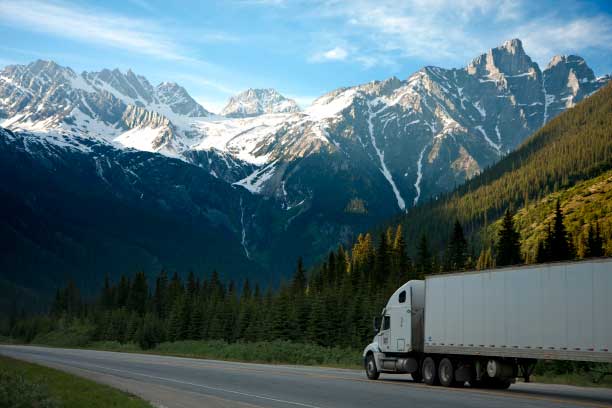 The U.S. nursery industry is responsible for shipping nearly $14 billion worth of products every year, including nearly $1 billion from Oregon alone, according to the most recent USDA Census of Horticultural Specialties.
The U.S. nursery industry is responsible for shipping nearly $14 billion worth of products every year, including nearly $1 billion from Oregon alone, according to the most recent USDA Census of Horticultural Specialties.
Whether these plants, trees and shrubs are destined to live for a season or a century, they must make their way along America’s highways, railroads, rivers and oceans before reaching their forever homes.
Without a way to transport these plant products, that $14 billion in sales would evaporate, as OAN Executive Director Jeff Stone well knows.
“It’s important for us as an industry to look short term and long term for our transportation needs,” he said, “so wherever we have a market, our members have a way to deliver that product.”
In Oregon, nurseries and other industries must ship their products via a transportation network dominated by 8,000 or so miles of state owned highways. Trucks at some point carry 80 percent of the goods headed out of Oregon and 75 percent of those heading in.
But that network — though it reaches almost every corner of the state — is facing two serious threats. One is deterioration of infrastructure. The other is congestion.
Deteriorating roads and bridges
Earlier this year, the Oregon Department of Transportation issued a report entitled “Rough Roads Ahead 2,” which noted that more than half of the state’s 2,736 highway bridges were built before 1970. Most of these have exceeded their 50-year design life, and weren’t designed to withstand a seismic event.
“At some point you have to replace them to keep them open to traffic,” said Travis Brouwer, assistant director of ODOT.
But according to the Rough Roads report, “the current ODOT bridge budget is able to fund an average of three bridge replacements a year. At this rate, it would take over 900 years to replace Oregon’s state bridges.”
The report also found that it’s cheaper to keep up with maintenance than let conditions get worse.
Maintaining bridges and pavement to today’s conditions would cost an additional $2.6 billion over the next 20 years. To let them deteriorate and then return them to current conditions would cost twice as much. Meanwhile, bridges in poor condition would be at risk of having weight restrictions imposed. That in turn could force lengthy reroutes of full loads to avoid the compromised bridges.
Congested highways
Equally dangerous to Oregon’s highway network is the threat of congestion, particularly in the Portland area.
There are several stretches of freeway where chronic slowdowns have become the norm at all hours of the day, not just during the traditional morning and evening rush hours.
The worst bottleneck is the Rose Quarter in downtown Portland, where the West Coast’s main thoroughfare, Interstate 5, comes together with Interstate 84, which is Oregon’s main connection to areas outside the West Coast.
“It is the worst bottleneck in Oregon and one of the worst in the country,” Brouwer said. “It’s congested 12 hours a day. It’s a very bad section of freeway.”
Nearly as bad are Highway 217, which connects Portland’s western suburbs, and Interstate 205, which runs north to south through Portland’s eastside and provides an alternate through route for those wishing to avoid downtown.
One can scarcely plan a route through the Portland area without hitting one of those bottlenecks. For most Oregon nurseries, that’s a problem. Three of the state’s top five nursery counties — Clackamas, Washington and Multnomah — are all part of the Portland metropolitan area. The other two — Marion and Yamhill — border on it.
“The congestion is impacting not only the movement of people but the movement of freight,” said state Rep. Caddy McKeown (D-Coos Bay). “Movement of freight is the basis of a strong economy. Every minute your truck sits idle, you’re wasting money.”
‘Movement of freight is the basis of a strong economy. Every minute your truck sits idle, you’re wasting money.’
— State Rep. Caddy McKeown (D-Coos Bay)
Finding solutions1
For the past several sessions, the Oregon Legislature struggled to come up with a major transportation package to deal with the dual threats of deterioration and congestion.
But in 2017, a concerted effort that lasted almost the entire length of the regular session finally succeeded where other attempts had failed.
The Oregon Legislature approved House Bill 2017, which came to be known as the Keep Oregon Moving bill, and it was signed by Gov. Kate Brown. It created a funding package that is anticipated to raise $5.3 billion for transportation improvements over the next decade.
“Overall this is a very significant investment in the transportation system, the largest in several generations,” Brouwer said. “It will really improve transportation at both the local and state level, and will improve transportation across all the modes, not just roads, but rail, transit and bicycles. The more options we give people, the more room we create on the road for trucks, so you guys can get your goods to market.”
The bill’s origins lie in a 14-member task force that was formed in 2016 and held public meetings in 11 communities around the state. It included members of both major political parties, as well as both chambers of the legislature. The resulting bill was based on the task force’s findings.
“It was built in the right way in Salem, by bipartisan and bicameral involvement,” said Stone, who closely observed the process. “It’s a good example of how to build a complex and significant policy in this state.”
Sharing the cost
The task force recommended that all interested parties be asked to share the burden of paying for the investments that will be made. “We walked into our community meetings with a really important concept, which was that everybody needs to have skin in the game,” McKeown said.
The final bill reflected that principle. It includes increases in gas taxes, vehicle registration fees and title fees, as well as a new tax on adult bicycles that cost $200 or more, a payroll tax of 0.1 percent that workers will pay, and a vehicle sales tax.
The registration and title fees will include surcharges for electric vehicles and hybrids, which tend to pay less in gas taxes because they burn less fuel.
Rep. Cliff Bentz (R-Ontario) was one of four legislators playing key roles in the drafting the bill, along with McKeown and Sens. Lee Beyer (D-Springfield) and Brian Boquist (R-Dallas). He noted that the gas tax increase is to be phased in over eight years.
The gas tax goes up by 4 cents in 2018, followed by 2 cents in 2020, 2022 and 2024.
“Each of those additional 2 cent increases are conditioned on ODOT meeting certain standards established in the bill,” Bentz said. “We’ve said to ODOT, before you get any money you’ve got to show you’re doing what’s called for in the bill.”
The gradual increase “was designed to allow freight companies time to adapt their contractual obligations,” Bentz added. “We phased it in over time to allow our freight dependent industries time to acclimate to the additional cost.”
The fee structure was devised in consultation with the trucking industry as well as the American Automobile Association, which represents motorists. That should help the funding package avoid any initiative challenge at the ballot box.
“There’s been no one talking about referring it,” Bentz said. “It’s because we’ve made the case that you have to fix what you use.”
Investing in solutions
Where will the money go? To addressing highway deterioration and congestion, both through maintenance and preservation projects, and new investments in highways and other modes of transportation that can provide congestion relief.
“The primary focus of the bill was preservation and maintenance,” Bentz said.
By law, the money from gas tax increases must go to highways. Half of the road funding will go to cities and counties.
For bottlenecks, the bill sets aside funding to address Interstate 5 through the Rose Quarter, a widening of Highway 217, and two projects along Interstate 205. Discussed, but left out of the bill, was a project to widen I-205 from Stafford to Oregon City, including the Abernethy Bridge over the Willamette River, but that will be studied.
The bill also allows for tolls and value pricing in the Portland metropolitan area if certain requirements are met and the federal government approves. Any proceeds could be used for funding additional projects that are needed in the area, without the rural parts of the state paying for what’s needed in Portland.
“People using the systems would pay for them,” Bentz said.
The funding package would pay for better public transportation in rural areas, as well as safety features for pedestrians and bicyclists. There’s also funding for ports and rail, including two intermodal facilities. One will be in eastern Oregon and the other somewhere in the mid-Willamette Valley.
These would allow “transloading products from rail to truck or truck to rail,” McKeown said. “It means being able to move product out without getting hung up in the juggernaut that is the metro area.”
She added that highway users would benefit indirectly.
“For every rail car that you move, you’re taking 3.3 trucks off the highway,” McKeown said. “You’ve significantly lowered emissions and you’ve lowered traffic and congestion. You’ve taken a maintenance load off the highway.”
Making it equitable
According to Stone, the bill did a good job of balancing costs and deliverables.
“The cost of doing business in the state is something that we pay close attention to,” he said. “We compete against states that have significantly lower wage levels. But congestion has a price, and the shippers end up paying it in the form of more hours on the road. Eliminating delays frees up those trucks to come in, pick up the load and get out.”
Stone is hopeful that Oregon’s commitment to transportation and freight movement will serve as an example to the federal government and there is further investment in transportaiton.
“Transportation investment is cumulative,” he said. “These types of investments need to be matched by the U.S. Congress.”




